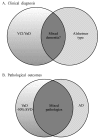Small vessel disease and subcortical vascular dementia
- PMID: 20396480
- PMCID: PMC2854938
- DOI: 10.3988/jcn.2006.2.1.1
Small vessel disease and subcortical vascular dementia
Abstract
Atherothromboembolism and intracranial small vessel disease are considered to be the main causes of cerebrovascular injury, which may lead to cognitive impairment and vascular dementia (VaD). VaD appears to be the second most common type of dementia with prevalence estimates of 10-15%. Cortical or multi-infarct dementia and subcortical vascular dementia (SVD) are suggested to be the two main forms of VaD. The main clinical features of SVD comprise decreased motor performance, early impairment of attention and executive function with slowing of information processing. SVD results from lacunar infarcts or multiple microinfarcts in the basal ganglia, thalamus, brainstem and white matter and are associated with more than 50% of the VaD cases. White matter changes including regions of incomplete infarction are usually widespread in VaD but their contribution to impairment of subcortical regions is unclear. While most of VaD occurs sporadically only a small proportion of cases bear clear familial traits. CADASIL is likely the most common form of hereditary VaD, which arises from subcortical arteriopathy. SVD needs unambiguous definition to impact on preventative and treatment strategies, and critical for selective recruitment to clinical trials.
Keywords: CADASIL; Cerebrovascular disease; Cognitive impairment; Dementia; Ischaemia; Lacunes; Small vessel disease; Stroke.
Figures


References
-
- Berrios GE, Freeman HL. Alzheimer and the dementias. London: Royal Society of Medicine Services; 1991. pp. 69–76. Eponymists in Medcine series.
-
- O'Brien JT, Erkinjuntti T, Reisberg B, Roman G, Sawada T, Pantoni L, et al. Vascular cognitive impairment. Lancet Neurol. 2003;2:89–98. - PubMed
-
- Roman GC, Erkinjuntti T, Wallin A, Pantoni L, Chui HC. Subcortical ischaemic vascular dementia. Lancet Neurol. 2002;1:426–436. - PubMed
-
- Roman GC, Tatemichi TK, Erkinjuntti T, Cummings JL, Masdeu JC, Garcia JH, et al. Vascular Dementia: Diagnostic Criteria for Research Studies. Report of the NINDS-AIREN International Work Group. Neurology. 1993;43:250–260. - PubMed
-
- Erkinjuntti T. Clinical criteria for vascular dementia: The NINDS-AIREN criteria. Dementia. 1994;5:189–192. - PubMed
LinkOut - more resources
Full Text Sources

